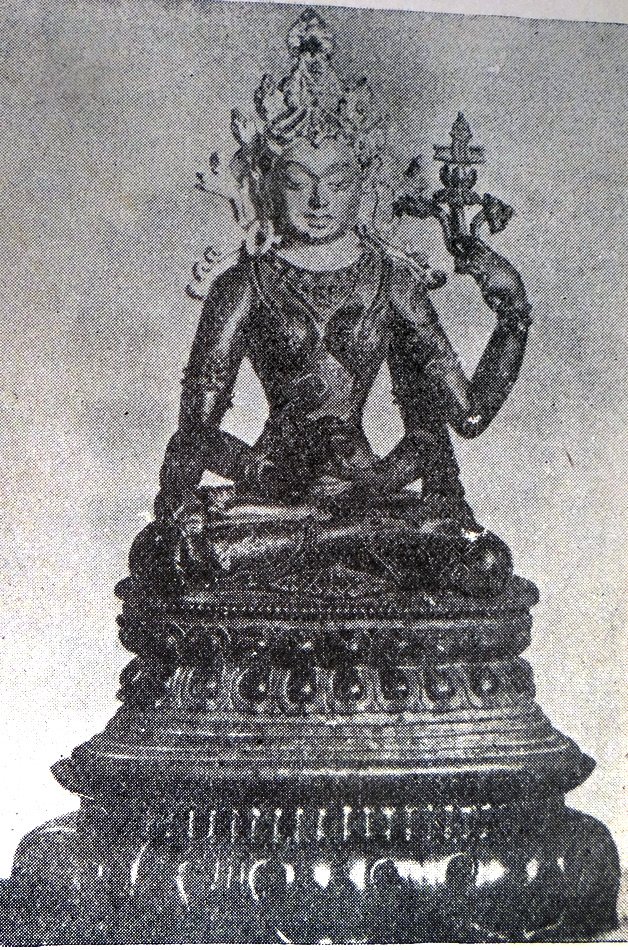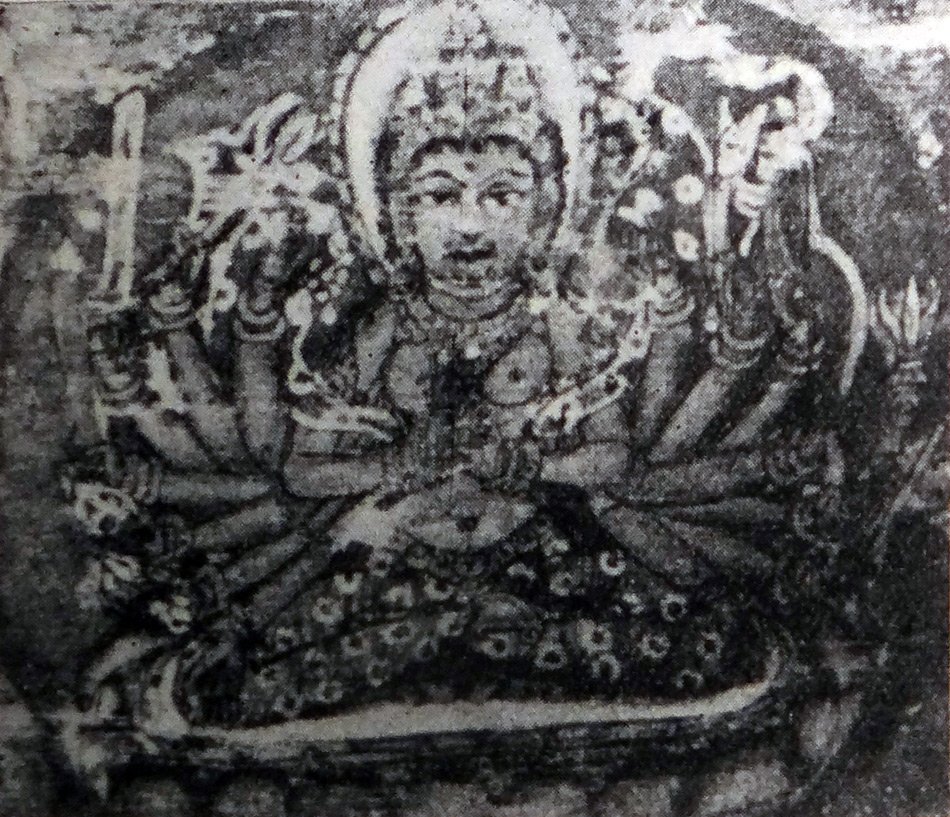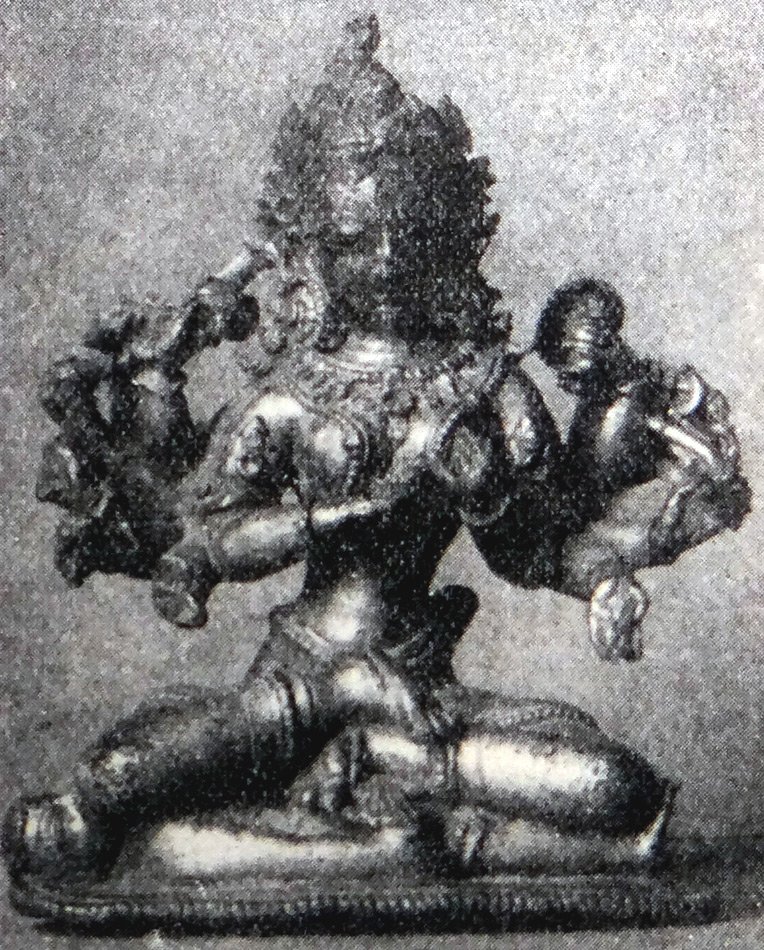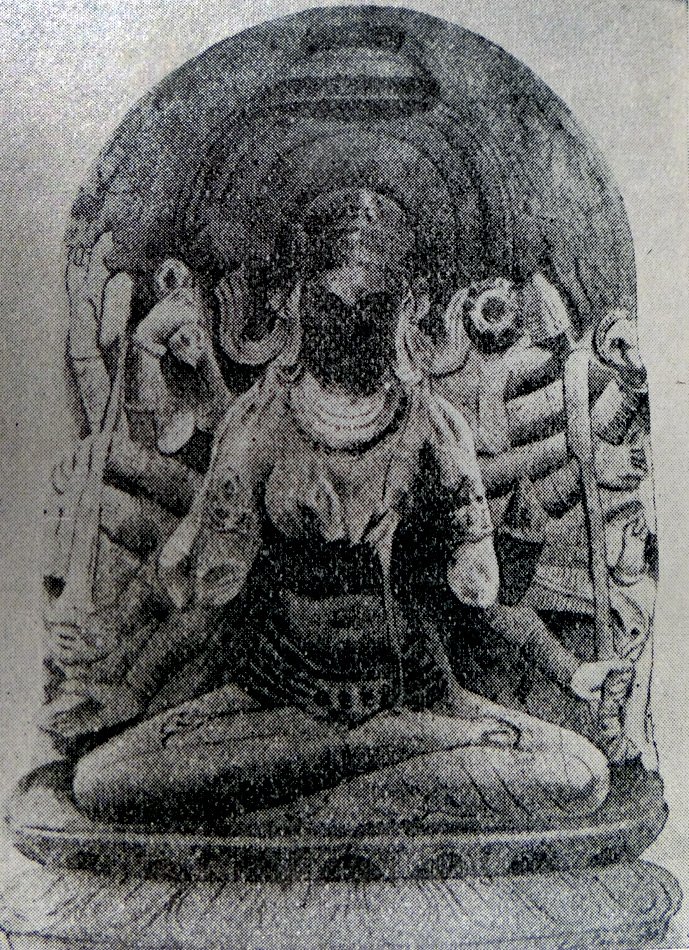The Indian Buddhist Iconography
by Benoytosh Bhattachacharyya | 1958 | 51,392 words | ISBN-10: 8173053138 | ISBN-13: 9788173053139
This page contains an iconography image of Emanations of Vairocana: Cunda and represents figure 161-164 of the book Indian Buddhist Iconography, based on extracts of the Sadhanamala English translation. These plates and illustrations represent either photographs of sculptures or line-drawing reproductions of paintings or other representations of Buddhist artwork.
Figure 161-164 - Emanations of Vairocana: Cundā
 Fig. 161: Cundā (W.B. Whitney collection, New York) |
 Fig. 162: Cundā (Miniature painting from a cambridge Ms.) |
 Fig. 163: Cundā (Bodh Gaya) |
 Fig. 164: Cundā (Bodh Gaya) |
Colour: white;
Symbol: book on lotus;
Face: one;
Arms: two, four, sixteen, eighteen and twenty-six.
According to a definite statement s contained in the Niṣpannayogāvalī under the Mañjuvajra Maṇḍala, Cundā is affiliated to the Dhyāni Buddha Vairocana, and thus Cundā is the spiritual daughter of Vairocana, and is required to be classed under the emanations of this very Dhyāni Buddha.
The name of the deity is spelt variously as Cundā, Cundrā, Candrā, Caṇḍā, and Cuṇḍrā. She is also called Cundavajrī. The spelling of Cundā as adopted by Foucher appears to be correct since her mantra as given in the Sādhanamālā: “Oṃ Cale Cule Cunde Svāhā” contains the word Cundā in the vocative as Cunde. Under the circumstances the correct spelling and the name of the deity as Cundā may be taken as certain.
From the Sādhana it is not possible to ascertain the character of the deity or her origin. But from a reference in the Niṣpannayogāvalī it appears probable that the deity Cundā is the embodiment of the Buddhist Dhāriṇī work called the Cundādhāriṇī to which a reference is made by Śāntideva. The Niṣpannayogavālī acknowledges altogether twelve Dhāriṇī deities and gives their descriptions. These Dhāriṇīs look alike when represented and they are usually two-armed, holding the Viśvavajra in the right hand and their special symbols in the left.
The names of the twelve Dhāriṇīs as given in the Niṣpannayogavālī are these: 1. Sumati, 2. Ratnolkā, 3. Uṣṇīṣavijayā, 4. Mārī, 5. Parṇaśabarī, 6, Jāṅgulī, 7. Anantamukhī, 8. Cundā, 9. Prajñāvardhanī, 10. Sarvakarmāvaraṇaviśodhanī, 11. Akṣayajñānakaraṇḍā and 12. Sarvabuddhadharma-Koṣavatī. These Dhāriṇīs are collectively assigned to the Dhyāni Buddha Amoghasiddhi, and are described later in this book.
The Dhāriṇīs are a peculiar kind of Buddhist literature which is supposed to generate great mystic power if repeated continually for a long time. They are short works mostly composed of meaningless syllables, sometimes revealing traces of a language now defunct. The deification of books is not unknown in Buddhism. The best example of this is the deity Prajñāpāramitā, who is the embodiment of the great Mahāyāna scripture, the Prajñāpāramitā, which is believed to have been rescued from the nether regions by Nāgārjuna the Pontiff.
Amongst the Dhāriṇī deities Uṣṇīṣavijayī, Jāṅgulī, Parṇaśabarī and Cundā are popular, and there are Sādhanas and images of these deities in art. But they represent nothing more than the respective Vidyās or mantras of which they are the embodiments.
Cundā thus is the embodiment of the Cundā Dhāriṇī or the Cundā-mantra. The Buddhists believe that when the Dhāriṇī is repeated in deep meditation for a long time with concentration and faith, the mantra vibrations grossen themselves in the concrete form of a deity which the worshipper visualizes, and thus obtains Siddhi or success. Once realized, the deity never leaves the worshipper and gives him everything that he desires.
With regard to the antiquity of Cundā in the Buddhist pantheon, it may be said that the very first mention of her name Candrā which is considered to be the same as Cundā, appears in the Mañjuśrīmūlakalpa, the composition of which is usually placed cir. 200 A. D. As Cundavajrī, she finds mention in one of the earliest Tantric works, the Guhyasamāja which was written most probably in the time of Asaṅga, cir.300 A. D, Cundā is also mentioned in the Śikṣāsamuccaya of Śāntideva in the 7th century. Cundā images are found in illuminated Prajñāpāramitā MSS of the 11th century and several Sādhanas are dedicated to her in the Sādhanamālā, the earliest MS of which bears a date which is equivalent to A. D. 1165. Earlier, she is mentioned in the Niṣpannayogāvalī of Abhayākara Gupta (C 1130. A. D.).
So far only three Sādhanas of Cundā are known, and they are all to be found in the printed edition of the Sādhanamālā as Nos. 129, 130, and 131. There is a further description of the goddess in the same book where Cundā is included as a minor deity in the Maṇḍala of Aṣṭabhuja-Kurukullā. Three more descriptions are available in the Niṣpannayogāvalī.
The three Sādhanas in the Sādhanamālā describe the principal deity Cundā in one form only. She is four-armed, one-faced and of white complexion. The Dhyāna is given below:
“She is of the colour of the autumn moon, and is four-armed. She shows the Varada-mudrā in the right hand and holds the book on a lotus in the left. The two other hands hold the bowl. She is decked in all ornaments”.
Only one image of Cundā (Fig. 161) of this description was in the collection of the late Mr. W. B. Whitney of America. The illustration is from a photograph kindly supplied by the owner.
The Sādhanamālā also makes Cundā a companion deity of Aṣṭabhujā Kurukullā in Sādhana No. 174, p. 352. In the Īśāna corner of the Kurukullā Maṇḍala on a lotus petal sits Cundā while the other petals are occupied by Prasannatārā in the east, Niṣpannatārā in the south, Jayatārā in the west, Karṇatārā in the north, Aparājitā in the Agni corner, Pradīpatārā in the Nairṛta corner and Gaurītārā in the Vāyu corner.
All the deities including Cundā look alike and are described as follows:
“All these deities are red in colour. They wear a crown with the figures of the five Dhyāni Buddhas, and sit in the Vajraparyaṅka attitude, With the two right hands they show the Varada-mudrā and the arrow drawn to the ears. They carry in their two left hands the blue lotus and the bow”.
In the Niṣpannayogāvalī there are altogether three descriptions of Cundā. In the Kālacakra Maṇḍala, Cundā is the consort of Ṭakkirāja who is similar to Ratnasambhava in appearance The relevant passage is given below:
“Cundā is white in colour. In the two right hands she carries the Mudgara (club) and the Kunta (knife) and in the two left the Padma (lotus) and the Daṇḍa (staff)”.
Cundā is once again mentioned in the Dharmadhātuvāgīśvara Maṇḍala. In this Maṇḍala her form is described in the following words:
“Cundā is white in colour. She carries in her two hands the rosary to which a Kamaṇḍalu is suspended”.
A third form of Cundā is described in the Niṣpannayogāvalī in the Mañjuvajra Maṇḍala. It is an elaborate description of Cundā who is here endowed with as many as twenty-six arms. The relevant extract is quoted below:
“Cundā is moon-white in colour. She has twenty-six arms. With the two principal hands she exhibits the chief mudrā. In the remaining right hands she shows the 1. Abhaya-mudrā, 2. sword, 3. garland of jewels, 4. citron, 5. arrow, 6. axe, 7. club, 8. hammer, 9. goad, 10. thunderbolt, 11. Tripatākā and 12. rosary. In the remaining left hands she shows the 1. flag marked with Cintāmaṇi jewel, 2. lotus, 3. Kamaṇḍalu, 4. noose, 5. bow, 6. javelin, 7. discus, 8. sword, 9. Tarjaṇī (raised index finger), 10. bowl, 11. Bhiṇḍipāla and 12. the Prajñāpāramitā Scripture”.
Although images of Cundā with twenty^six arms are not available, there are several images of Cundā with sixteen arms. These can be identified with the help of a miniature painting of sixteen-armed Cundā (Fig. 162) available in the manuscript No. Add 1643 of Prajñāpāramitā in the Cambridge University Library.
This miniature bears a label in old Newari characters which reads as:
“Paṭṭikere Cundāvarabhavane Cundā”
“Cundā in the excellent temple of Cundā at Paṭṭikera”.
This inscription leaves no room for doubting the identification of the sixteen-armed image as that of Cundā. In this figure also the principal pair of hands exhibits against the chest the mudra which is called in the Sādhanas the Mūla-mudrā which is akin if not equal to the Dharmacakra-mudrā. Foucher has given a description of the miniature of Cundā in his L’Iconographie Bouddhique, part I, p. 199. According to him the two principal hands exhibit the mudrā of teaching. The remaining seven right hands show the 1. Varada-mudrā, 2. thunderbolt, 3, discus, 4. club, 5. dagger, 6, (indistinct) and 1. rosary. In the seven left hands she carries the 1. vessel, 2. axe, 3. trident, 4. bow, 5. dagger, 6. (indistinct) and 7. sceptre. Dr. N. K. Bhattasali gives a slightly different description of the same miniature.
Thus it is apparent that there was an image of Cundā in the Cundā temple at Paṭṭikera which is identified by Dr. Bhattasali with the remains on the Lalmai hills in Tippera in East Bengal The miniature of the Prajñāpāramitā manuscript obviously depicts the sixteen-armed image of Cundā, and thus becomes instrumental in identifying several of her unidentified images.
The Baroda Museum image (Fig. 163) is one such image and is a small and very artistic piece made of the usual octo-alloy of the Nepalese school. Thinly covered in the front part with a golden leaf or polish which has faded out at many places, on a pedestal there is the prostrate figure of a man lying on his back. In the Paryaṅka-āsana the deity sits on the prostrate figure. She is richly dressed and is decked in ornaments such as necklace, chain, tiara, ear-rings, bracelets, armlets, anklets and girdle. She is sixteen-armed. The two principal hands are arranged in the form of a mudra which is akin to Dharmacakra. The remaining seven right hands show downwards from the top the 1. sword, 2. Ḍamaru (kettle-drum), 3. knife, 4. (broken), 5. hammer, 6. garland of jewels, 7. Abhaya-mudrā. The remaining seven left hands show likewise the 1. discus, 2. bell, 3. noose, 4. dagger, 5. goad, 6. arrow ard 7, Varada-mudrā. The deity is one-faced.
The Baroda Museum image has therefore to be identified with Cundā, although there is some minor variation. Similarly, the Bodh Gaya image found in the Hindu monastery (Fig. 164) has also to be identified with Cundā with sixteen arms. One more stone image of Cundā is illustrated in the History of Bengal, Vol. I, pi. xxvi, 64. Here Cundā has eighteen arms instead of sixteen as in the miniature.
The special feature of the Baroda Museum image is its seat which is on the prostrate figure of a man. This kind of special seat is absent in all other images of Cundā so far discovered either in stone or in metal. But this seat appears to be a special feature of the Cundā images which it, not against the direction of the Sādhana. Cundā is said in the Sādhana to be seated on a Sattvaparyaṅka or a seat spread on a ‘Sattva’ which usually means a man or an anima. This particular bronze gives the indication that Sattvaparyahka is a seat that is placed on a man lying on his back.
Cundā is popular both in Tibet and China.
